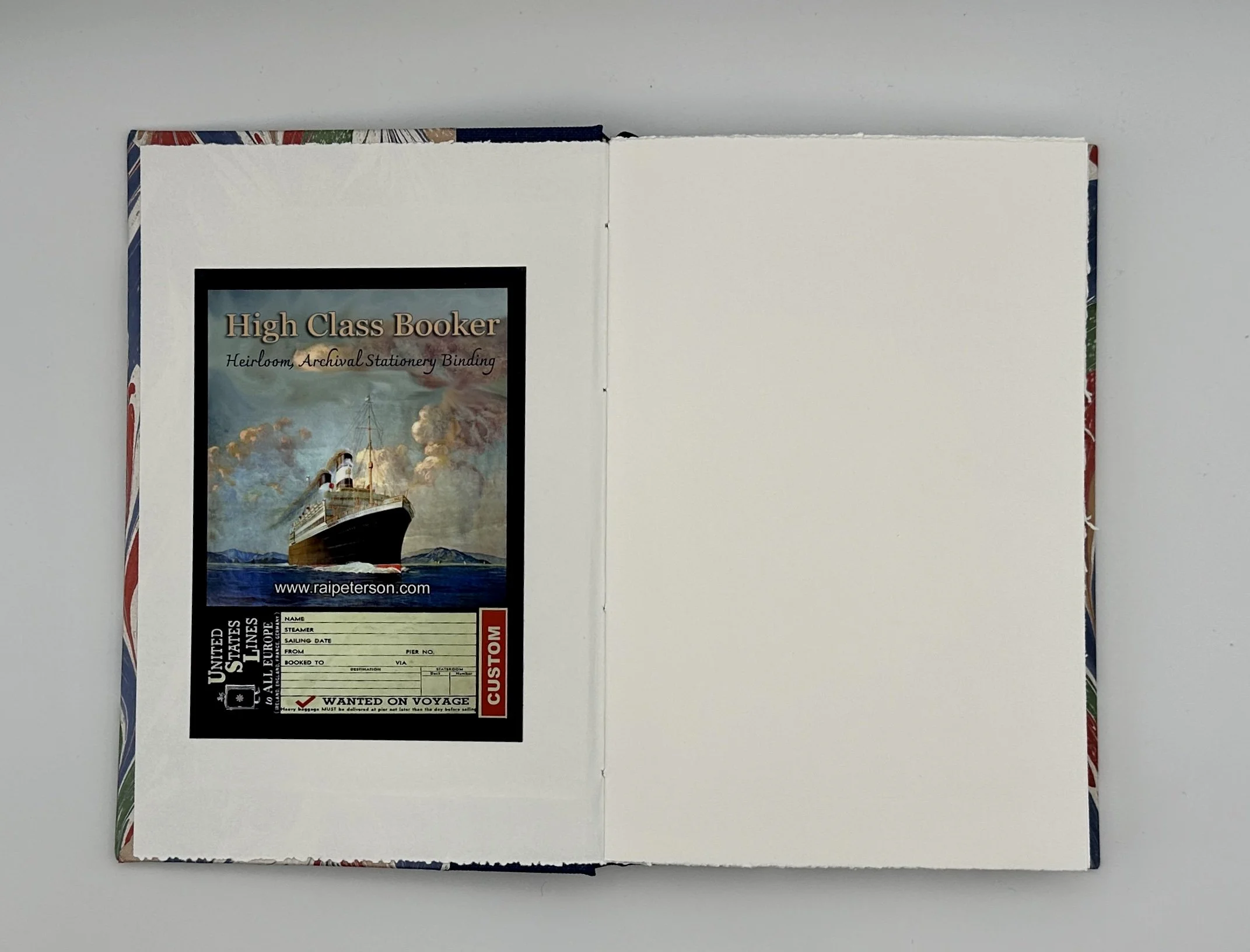Rise
This archival, hand-sewn journal/sketchbook is made from 80 gsm Mohawk Superfine archival paper stitched with Irish linen thread in the linked pattern that dates back to the ancient Copts. This stitch allows the book to lay open easily at any page.
This book’s endbands are red, green and yellow silk, and its bookmark is a blue satin ribbon. Its spine is covered top grain split French goatskin, and its boards are wrapped in Japanese paper that was silk-screened in a factory where kimono fabric is printed.
Treasure binding began with monks in the 6th Century who would encrust volumes with jewels. During the Renaissance, there was a resurgence in treasure binding. This is a contemporary revival of the treasure binding in which a lucky charm has been embedded in the cover of this book.
The talisman in this journal is a vintage Reed and Barton silver and gold damascene broach ornament depicting a a hot air balloon in flight. The word “uplift” comes from the Middle Ages when it seems to have occurred in Middle Swedish “uplyfta,” Middle Danish “opløfte,” and Middle English “uplift” around the same time. It’s first recorded use in English is from a 1338 encomium celebrating the reign of King Edward I. May you inspire such admiration.
This archival, hand-sewn journal/sketchbook is made from 80 gsm Mohawk Superfine archival paper stitched with Irish linen thread in the linked pattern that dates back to the ancient Copts. This stitch allows the book to lay open easily at any page.
This book’s endbands are red, green and yellow silk, and its bookmark is a blue satin ribbon. Its spine is covered top grain split French goatskin, and its boards are wrapped in Japanese paper that was silk-screened in a factory where kimono fabric is printed.
Treasure binding began with monks in the 6th Century who would encrust volumes with jewels. During the Renaissance, there was a resurgence in treasure binding. This is a contemporary revival of the treasure binding in which a lucky charm has been embedded in the cover of this book.
The talisman in this journal is a vintage Reed and Barton silver and gold damascene broach ornament depicting a a hot air balloon in flight. The word “uplift” comes from the Middle Ages when it seems to have occurred in Middle Swedish “uplyfta,” Middle Danish “opløfte,” and Middle English “uplift” around the same time. It’s first recorded use in English is from a 1338 encomium celebrating the reign of King Edward I. May you inspire such admiration.
This archival, hand-sewn journal/sketchbook is made from 80 gsm Mohawk Superfine archival paper stitched with Irish linen thread in the linked pattern that dates back to the ancient Copts. This stitch allows the book to lay open easily at any page.
This book’s endbands are red, green and yellow silk, and its bookmark is a blue satin ribbon. Its spine is covered top grain split French goatskin, and its boards are wrapped in Japanese paper that was silk-screened in a factory where kimono fabric is printed.
Treasure binding began with monks in the 6th Century who would encrust volumes with jewels. During the Renaissance, there was a resurgence in treasure binding. This is a contemporary revival of the treasure binding in which a lucky charm has been embedded in the cover of this book.
The talisman in this journal is a vintage Reed and Barton silver and gold damascene broach ornament depicting a a hot air balloon in flight. The word “uplift” comes from the Middle Ages when it seems to have occurred in Middle Swedish “uplyfta,” Middle Danish “opløfte,” and Middle English “uplift” around the same time. It’s first recorded use in English is from a 1338 encomium celebrating the reign of King Edward I. May you inspire such admiration.






